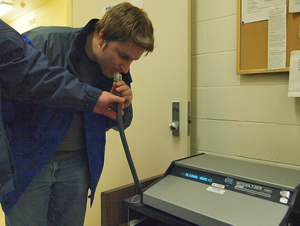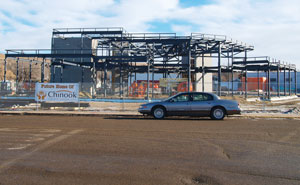
The things I do for science.
On Friday, January 27, the Drumheller detachment of the RCMP asked a few willing participants, myself included, to bust the myth that having two drinks over an hour long dinner will put you over the limit of 0.05 percent blood alcohol content and could result in you getting a 24 hour suspension.
To give some context into my test results, there are a couple things you should know about me. I am a 27 year old male and weigh approximately 185 lbs. I only had a sandwich about 4 hours prior to the test, so I was close to having an empty stomach.
Before heading over to test the myth, I chose my beverage, an ale labeled as 5 per cent alcohol per volume. Other participants had either brought lagers or mixed drinks. In retrospect, maybe I should have brought a bottle of wine.
The study was simple. We were to drink two beverages in under 10 minutes, a speed I never do, then wait 20 minutes and use a standard roadside testing device and the Intoxilyzer 5000 C to measure our blood alcohol levels.
The design of the test was to ensure that we had the greatest amount of alcohol in our system and thus have the highest result possible from two drinks.
After I finished my two ales, I recorded 0.041 on the roadside testing device and 0.042 on the Intoxilyzer. Both results were below the limit.
As for the other participants, several were men above 200 lbs. and their test results barely registered any alcohol in their system. A female, weighing between 100 lbs. and 120 lbs. scored 0.062, which is above the limit.
None of the participants had been eating anything substantial during the test.
The results suggest that your average person going out for an hour long dinner and having a couple drinks would not have enough alcohol in their system to put them over the 24 hour suspension limit.
Then commenced the second phase of the test. We were asked to consume our beverages until we felt that we could no longer operate a motor vehicle.
Like a good guinea pig, I proceeded to consume five more beverages over the next hour.
After I was done I tested at 0.128. The larger participants still tested below 0.05, but felt that they were in no condition to drive.
All the while, we were observed for signs of impairment. An interesting result was that despite being below the limit, the other participants were showing signs of being impaired.
The results of the second part of the experiment suggest to me that safe driving is not about numbers on a device, rather, it’s about knowing your limits. There are a vast array of signs, some of which are entirely out of any conscious control, that the RCMP can use to determine impairment. Even if you could consistently test under the limit no matter how much you imbibe, the signs of impairment would give you away.
After my final drink I was well and truly done and I decided to go home. But, like any responsible adult, I got a ride.

















